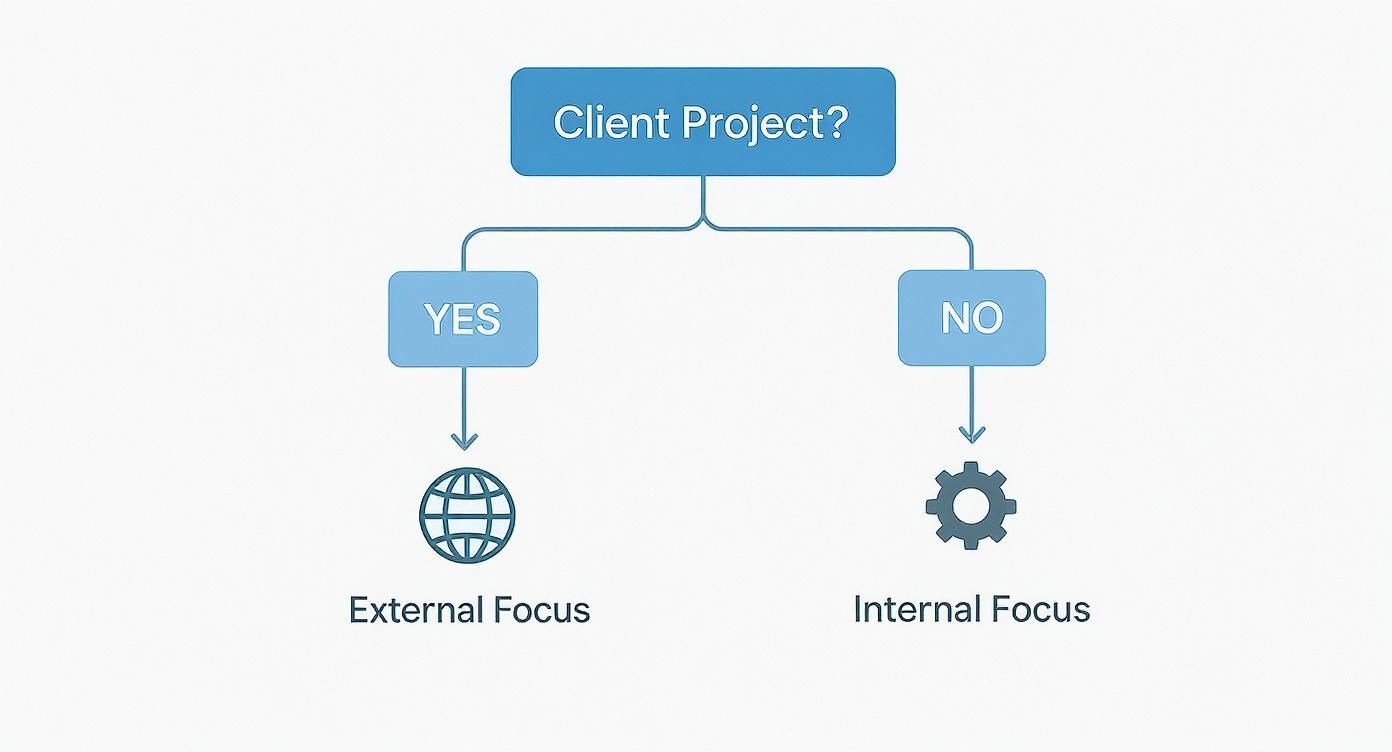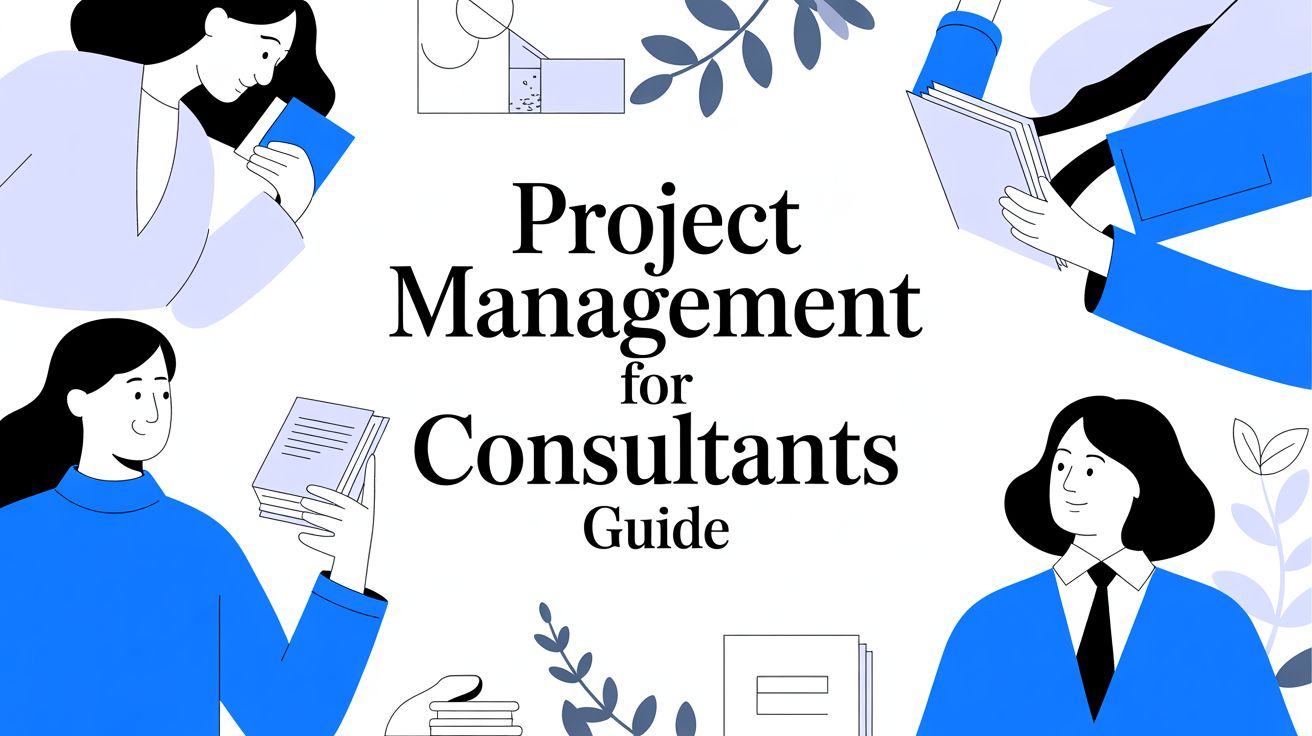- Why Project Management for Consultants Is a Unique Skill
- The Consultant’s Balancing Act
- Core Pillars of Consulting Project Success
- How Consulting Projects Are Different From Internal Projects
- Navigating External Pressures and Politics
- The Ambiguity of Scope and Success
- Key Differences at a Glance
- Choosing the Right Consulting Project Management Methodology
- When to Use the Waterfall Approach
- Embracing Flexibility with Agile
- The Best of Both Worlds with a Hybrid Model
- Choosing Your Consulting Methodology
- The Modern Consultant’s Project Management Toolkit
- Core Components of a Consultant’s Tech Stack
- Creating a Single Source of Truth in Action
- Why Integrated Tools Are Non-Negotiable
- Navigating the Five Phases of a Consulting Project
- Phase 1: Scoping and Proposal
- Phase 2: Kickoff and Alignment
- Phase 3: Execution and Monitoring
- Phase 4: Deliverable and Presentation
- Phase 5: Closure and Follow-up
- Future-Proofing Your Project Management Skills
- The Rise of Emotional Intelligence and AI
- Focusing on Value Over Deliverables
Project management in consulting is a different beast altogether. It’s a special blend of high-level client strategy and relentless, disciplined execution. We’re talking about more than just tracking tasks on a Gantt chart; it’s about steering high-stakes projects to the finish line while juggling tight deadlines, ever-changing scope, and a complex web of stakeholders.
Get it right, and you don’t just complete a project. You deliver real, tangible value, cement your client’s trust for the long haul, and keep your firm profitable. It’s the difference between a one-off gig and becoming a go-to strategic partner.
Why Project Management for Consultants Is a Unique Skill

If you’ve ever felt like standard project management advice just doesn’t quite land in your world, you’re not imagining things. Unlike a typical internal corporate project, consulting engagements are played on a different field with a unique, and much more intense, set of rules.
Think about it. An internal team might be building a new software feature with colleagues they know well and timelines that have some give. But a consultant? You’re tasked with delivering a similar project for a client with sky-high expectations, a locked-in budget, and a non-negotiable go-live date. Generic tactics just fall flat because they completely ignore the external pressures that define our reality.
The Consultant’s Balancing Act
This brings us to what I call the “consultant’s dilemma”—that constant tightrope walk between delivering deep strategic insight and pulling off flawless, on-the-ground execution. You aren’t just managing tasks; you’re managing a client relationship, their perception of your value, and the commercial health of the entire engagement.
A marketing consultant, for example, isn’t just launching a campaign. They’re simultaneously proving the campaign’s ROI to a skeptical VP of Marketing, managing contracts with third-party vendors, and making sure the project stays profitable for their own firm. Every single decision ripples out in multiple directions.
For consultants, project management isn’t some administrative chore to be endured. It’s a strategic weapon for building client trust, guaranteeing profitability, and creating a formula for repeatable success. It’s what transforms a chaotic sprint into a well-orchestrated victory.
This is exactly why a structured, yet flexible, approach is non-negotiable. Good project management is the framework that holds everything together, ensuring every action ties directly back to the client’s goals and your firm’s objectives. It’s the roadmap that turns abstract strategies into concrete, valuable results.
Core Pillars of Consulting Project Success
Success in this environment really boils down to mastering a few key areas that are fundamentally different from your run-of-the-mill internal project management:
- Continuous Value Demonstration: You have to constantly connect every project activity back to the client’s business objectives. For instance, instead of just saying “We completed the user research phase,” you’d say, “Our user research is complete, and the insights we’ve gathered already point to a potential 15% reduction in customer support calls.” It’s about showing progress and proving your worth at every single stage, not just at the end.
- Proactive Stakeholder Management: This is about more than just sending update emails. It’s about skillfully navigating client politics, aligning expectations across different departments, and getting buy-in from key decision-makers who might have completely different agendas. A practical example would be setting up a brief one-on-one with the Head of IT before a major kickoff meeting to address their specific concerns about data security, ensuring they feel heard and become an ally.
- Rigorous Scope Control: Protecting the project from “scope creep” is absolutely vital for keeping timelines and profitability intact. This takes a firm but fair hand when managing all those “quick little” client requests that pop up. For example, when a client asks to add a new reporting feature, you can respond warmly with, “That’s a fantastic idea. Let’s add it to our ‘Phase 2’ list so we can address it properly after we’ve hit our initial go-live date.”
At the end of the day, mastering project management is how great consultants build lasting partnerships and deliver work that actually moves the needle for their clients.
How Consulting Projects Are Different From Internal Projects
If you’ve ever jumped from an internal role into consulting, the change can feel like switching from playing checkers to three-dimensional chess. Sure, both involve strategy, but the rules, the pieces, and what’s at stake are on completely different levels. Getting your head around these differences is the first real step to mastering project management in a consulting firm.
Think about a typical internal project, like your company deciding to build a new employee onboarding portal. The stakeholders are your colleagues. The goals are tied to making things run smoother internally. You’re all working inside the same company culture, with a shared language and a built-in level of trust.
Now, contrast that with a consulting gig where you’re hired to roll out a new CRM for a client. Instantly, you’re an outsider. Your team has to figure out an unfamiliar corporate culture, report to external stakeholders who all have different expectations, and every single move you make is tied directly to a contract and a budget. The whole game just got a lot more complicated.
Navigating External Pressures and Politics
One of the biggest shifts is the sheer intensity of managing stakeholders. On an internal project, you might have to smooth over some friction between the IT and marketing departments. On a consulting project, you’re dealing with those exact same internal dynamics from the outside, while also managing the client’s perception of your firm’s value.
A consultant isn’t just a project manager; they’re a diplomat, a change manager, and a strategist all rolled into one. Your job is so much more than just tracking tasks—it’s about building consensus among people who might not even agree on what the problem is, let alone the solution.
This outsider position means you have to be incredibly deliberate with every communication. You can’t just rely on a casual chat in the breakroom to clear things up. Every update, meeting, and report needs to be crystal clear, professional, and laser-focused on building and keeping the client’s trust. For instance, a weekly status report for a client should be more than a task list; it should be a concise summary that highlights progress, flags potential risks with proposed solutions, and reaffirms how you’re tracking toward their business goals.
The Ambiguity of Scope and Success
Another key area where things differ is how scope and success are defined. Internal projects often have a bit of wiggle room. If a new feature request pops up, the team can usually find a way to adjust timelines or shuffle resources internally.
In consulting, the scope is your lifeline. It’s spelled out in a Statement of Work (SOW) and is directly tied to your firm’s bottom line. Scope creep—when clients ask for “just one more thing”—isn’t just a minor annoyance; it’s a direct threat to your budget and your deadline. A great consulting project manager becomes an expert at politely but firmly holding those boundaries.
This reality is why the global demand for skilled project leaders keeps climbing. Juggling multiple, complex client engagements is a specialized skill. In fact, research shows that over 85% of project managers are running several projects at the same time, which makes disciplined management absolutely critical. You can explore more project management statistics and how they guide planning for 2025.
Key Differences at a Glance
Let’s break down the main distinctions in a simple table.
| Aspect | Internal Project | Consulting Project |
|---|---|---|
| Primary Goal | Improve internal operations or products. | Deliver specific, contracted value to an external client. |
| Stakeholders | Mostly internal colleagues and leadership. | A complex mix of client executives, end-users, and internal teams. |
| Scope Definition | Often flexible and can evolve internally. | Rigidly defined by a contract and SOW; scope creep is a major risk. |
| Communication | Can be informal and relies on shared culture. | Must be formal, structured, and proactive to build trust. |
| Success Metrics | Internal KPIs, adoption rates, efficiency gains. | Client satisfaction, on-time/on-budget delivery, and contract renewal. |
At the end of the day, recognizing these differences helps you figure out why past projects went sideways and how to set up future ones for success. It’s all about shifting your mindset from just getting tasks done to orchestrating a successful engagement that delivers real, measurable value for the client—and ensures your firm stays profitable.
Choosing the Right Consulting Project Management Methodology
Picking the right project management methodology is one of those make-or-break decisions in any consulting gig. It’s like a builder choosing between a detailed blueprint and a flexible design-build process; one isn’t better than the other, but one is definitely right for the job at hand. Your methodology is the playbook for how you’ll plan, execute, and deliver, and it sets the tone for everything from client communication to final success.
There’s no silver bullet here. The consulting world is far too nuanced for a one-size-fits-all approach. The best path forward depends on the client’s culture, the project’s complexity, and how much is known—or unknown—from the outset. Getting this right means you can set rock-solid expectations, keep resources in check, and handle the inevitable surprises with confidence.
As you can see, the first fork in the road is often deciding if the project is for an external client or an internal team.

This matters because client-facing work demands a whole different level of communication, stakeholder wrangling, and tangible value demonstration compared to your internal initiatives.
When to Use the Waterfall Approach
The Waterfall methodology is the old guard of project management—a traditional, linear approach. Imagine building a house: you pour the foundation, then erect the frame, then add the walls, and finally, put on the roof. Each phase must be 100% complete before the next one can even begin. It’s methodical, sequential, and highly structured.
This method is your best friend when the project scope is clear, well-documented, and unlikely to budge. Think of projects like a regulatory compliance audit or a data center migration where the requirements are set in stone from day one.
Practical Example: A bank hires your firm to overhaul its systems to meet new government regulations by a hard deadline. The requirements are non-negotiable and spelled out in a 200-page document. Waterfall is perfect here. You can map out a detailed, phase-by-phase plan, get client sign-off at each milestone, and march steadily toward a clearly defined finish line.
Embracing Flexibility with Agile
On the flip side, Agile is all about iteration and learning as you go. Instead of one long, monolithic project, Agile chops the work into small, digestible chunks called sprints. It’s built for projects where the final destination isn’t fully mapped out, allowing you to gather feedback and pivot quickly.
Frameworks like Scrum and Kanban are godsends for software development, product innovation, or any engagement where requirements are expected to evolve. They’re built on a foundation of constant collaboration and prioritize responding to change over blindly following a plan.
Practical Example: A retail client asks your team to help them develop a new customer loyalty app. They have a vision but admit they’ll “know what they want when they see it.” Using Agile, you deliver a bare-bones but functional version of the app in a few weeks. The client tests it, gives feedback, and you use that intel to build the next batch of features. This cycle repeats, ensuring the final product is exactly what they need, not just what they thought they wanted at the start.
The core difference is your relationship with change. Waterfall is designed to resist change, while Agile is built to embrace it. For a consultant, knowing which one to deploy shows strategic foresight and a genuine understanding of the client’s problem.
The Best of Both Worlds with a Hybrid Model
Of course, sometimes neither pure Waterfall nor pure Agile feels right. That’s where a Hybrid approach steps in, blending the upfront planning of Waterfall with the iterative execution of Agile.
This model is a fantastic fit for complex consulting engagements. You might use a Waterfall approach for the big picture—defining the overall strategy, budget, and key milestones. But within that structure, your team can use Agile sprints to tackle the actual work, allowing for flexibility and discovery.
Practical Example: You’re hired to lead a major business process re-engineering project. The goal is firm: reduce operational costs by 15% within twelve months (that’s your Waterfall framework). But the how for each department is up in the air. You can plan the project in high-level phases but tackle each department’s transformation in iterative sprints, co-creating and testing solutions with their teams before moving on. This gives you both a predictable roadmap and the freedom to adapt, delivering a far better outcome.
Choosing Your Consulting Methodology
To make the decision clearer, it helps to see the methodologies laid out side-by-side. Every project has its own DNA, and matching it with the right framework is half the battle. This table breaks down where each approach typically shines in a consulting context.
| Methodology | Best For | Key Advantage for Consultants | Potential Pitfall |
|---|---|---|---|
| Waterfall | Projects with fixed scope, clear requirements, and predictable outcomes (e.g., compliance audits, infrastructure rollouts). | Provides a clear, predictable roadmap with defined milestones for client sign-off. Easy to budget and schedule. | Inflexible. A change in scope late in the game can be costly and disruptive, requiring significant re-planning. |
| Agile | Projects with evolving requirements and a high degree of uncertainty (e.g., new product development, software builds). | Allows for constant client feedback and course correction, ensuring the final deliverable truly meets their needs. | Can be harder to predict final timelines and budgets from the start, which can make some clients nervous. |
| Hybrid | Complex projects that need both high-level structure and execution-level flexibility (e.g., business transformations). | Offers the stability of a long-term plan with the adaptability of iterative work cycles. It’s the best of both worlds. | Requires a mature team that can balance and navigate two different mindsets without creating confusion. |
Ultimately, the goal isn’t just to pick a methodology but to adopt a framework that empowers your team and gives the client confidence. By understanding the strengths and weaknesses of each, you can make a strategic choice that sets your project up for success from the very beginning.
The Modern Consultant’s Project Management Toolkit

Picking the right methodology is one side of the coin. The other? Giving your team the right tools for the job. A smart tech stack is so much more than a digital to-do list—it’s the central nervous system for your entire consulting engagement. It keeps information flowing, teams aligned, and clients in the loop.
The real aim here isn’t just to check off tasks. It’s to create a single source of truth for every project. When you get this right, you dramatically cut down on those endless email chains, sidestep critical miscommunications, and give clients a clear, real-time window into your progress. An integrated toolkit helps your firm run like a well-oiled machine, from the first kickoff meeting to the final report.
Core Components of a Consultant’s Tech Stack
Modern project management for consultants isn’t about finding one magical app that does it all. It’s about building an interconnected system that supports the three pillars of any successful engagement: execution, communication, and knowledge retention.
Your toolkit should really be broken down into these essential categories:
-
Task and Timeline Management: Think of these as the engine of your project. Platforms like Asana, Trello, or Monday.com are built to visualize workflows, assign ownership, and track progress against deadlines. They transform a complex project plan into clear, actionable steps for everyone on the team.
-
Client Communication and Collaboration: This is where you nurture the most important relationship of all—the one with your client. Tools like Slack or Microsoft Teams create dedicated channels for projects, pulling conversations out of cluttered inboxes and into a focused, searchable space.
-
Knowledge Management: This becomes your firm’s institutional memory. Platforms like Notion, Confluence, or even a well-organized Google Drive act as a central library for every document, from the initial proposal and meeting notes to final deliverables and research findings.
Creating a Single Source of Truth in Action
Let’s walk through a real-world scenario. Imagine you’re a marketing consultancy hired to overhaul a client’s entire digital presence. Instead of drowning in emails and hunting for scattered files, your integrated toolkit brings calm to the chaos.
A “single source of truth” isn’t just a buzzword; it’s a practical strategy to eliminate ambiguity. When everyone—your team and your client—looks at the same dashboard for updates, the risk of working off outdated information virtually disappears.
Here’s how it would play out: the project plan lives in Monday.com, with every phase broken down into specific tasks assigned to team members with clear due dates. For daily check-ins and quick questions, your team and the client’s point of contact use a dedicated Slack channel. This keeps communication fast, contextual, and out of email hell.
Meanwhile, all the important assets—brand guidelines, market research, content drafts—are neatly organized in a shared Notion workspace. When a team member needs the latest version of a file, they know exactly where to look. No more “is this the final version?” emails. This simple, integrated approach is what makes a project flow seamlessly.
Why Integrated Tools Are Non-Negotiable
The reliance on these systems is growing, and fast. The project management software market is on track to hit $7.24 billion by 2025, and it’s no surprise when you see that around 82% of companies are already using these tools to work smarter. What’s more, with 57% of employees reporting they use more tools now than just a year ago, the writing is on the wall—an integrated tech stack is quickly becoming standard practice.
This kind of visual clarity is vital for consultants, as it allows both your team and the client to see project status at a glance. By building a robust toolkit, you’re not just managing tasks; you’re building a more professional, transparent, and effective consulting operation.
To dive deeper into specific platforms that can make this happen, check out our guide on the best consulting project management software available today.
Navigating the Five Phases of a Consulting Project
Every single consulting project, big or small, has a natural rhythm. It’s a journey with a clear beginning, middle, and end. Getting a handle on this lifecycle is the absolute core of effective project management for consultants. It’s how you turn potential chaos into a predictable, repeatable process that leaves clients happy.
Think of it less as a checklist and more as a roadmap. It’s all about building momentum, keeping everyone on the same page, and making sure every single action pushes you closer to the client’s goal. When you break the engagement down into five distinct phases, you can move from the first handshake to the final sign-off with confidence and control.
Phase 1: Scoping and Proposal
This is where it all begins—and honestly, where many projects are won or lost before they even kick-off. The Scoping and Proposal phase is all about deep listening and getting laser-focused on the details. Your main job here is to truly understand the client’s problem and then lay out a crystal-clear solution in your Statement of Work (SOW).
Get this part right, and you’re building a rock-solid foundation for success. A shaky scope is a recipe for scope creep and mismatched expectations down the line.
Critical Checklist:
- Conduct thorough discovery: Don’t just scratch the surface. Ask probing questions to uncover the real business challenge, not just the symptoms. For example, if a client says “we need a new website,” your follow-up might be, “What business problem are you hoping a new website will solve? Are leads down? Is customer engagement dropping?”
- Define clear objectives: What does a “win” look like for the client? Put a number on it whenever you can. Instead of “Improve sales,” aim for “Increase qualified leads by 20% within six months.”
- Outline specific deliverables: List out exactly what you will produce. No ambiguity. This means detailing things like “A 50-page market research report” or “A fully-functional 5-page website.”
- Set firm boundaries: Be explicit about what’s in scope and, just as importantly, what’s out of scope. A simple line like, “This proposal includes two rounds of revisions on all creative assets,” can save you from endless back-and-forth.
Phase 2: Kickoff and Alignment
With a signed proposal in your hand, it’s time to set the tone for the entire project. The Kickoff and Alignment phase is way more than just a quick meet-and-greet. A great kickoff is a strategic working session meant to get everyone—your team and the client’s—rowing in the same direction on goals, timelines, and the rules of engagement.
This is your chance to nail down how you’ll communicate and work together. Sorting this out upfront saves you from countless headaches later.
A great kickoff meeting isn’t just about what will be done; it’s about how it will be done. This is where you build the human-to-human trust that underpins a successful partnership.
Phase 3: Execution and Monitoring
Alright, this is the main event—the heart of the project where the real work happens. The Execution and Monitoring phase is a constant cycle of doing, tracking, and communicating. Your focus pivots from planning to actively managing tasks, timelines, and budgets, all while keeping a sharp eye out for any risks on the horizon.
Regular status updates are your best friend here. Whether it’s a formal weekly report or a quick daily check-in, keeping the client in the loop builds massive confidence and avoids any nasty surprises. This is also where diligent time tracking becomes non-negotiable for keeping a pulse on the project’s health. To make this work, many firms use specialized time tracking software for consultants to ensure every hour is accounted for and billed correctly.
Phase 4: Deliverable and Presentation
As you approach the finish line, the energy shifts to finalizing the work and presenting your findings. The Deliverable and Presentation phase is your time to shine. It’s where you get to show off all the value you’ve created and hand over the solution you promised way back in the proposal.
But this isn’t just about attaching a final report to an email. It’s about telling a compelling story that ties your work directly back to the client’s original problem, proving a clear return on their investment.
Pro-Tips for a Killer Presentation:
- Start with the “Why”: Remind everyone of the challenge you were hired to solve in the first place.
- Show, Don’t Just Tell: Use data, slick visuals, and real-world examples to make your points hit home.
- Focus on Outcomes: Zero in on the results and the tangible value your solution brings to the table.
- Outline Next Steps: Give the client clear, actionable recommendations on what to do next.
Phase 5: Closure and Follow-up
The project isn’t truly over when the final invoice gets paid. The Closure and Follow-up phase is what cements a long-term relationship. This is where you formally close everything out, ensure a smooth handover to the client’s team, and gather some incredibly valuable feedback.
A post-project review, or “post-mortem,” is a goldmine for continuous improvement. It helps you pinpoint what went well and what you can do even better next time. This final step is often what separates a one-off project from a lasting, profitable client partnership. For example, a simple follow-up email a month later asking, “How are the new processes working for your team?” can be incredibly powerful for building goodwill and spotting new opportunities.
Future-Proofing Your Project Management Skills
The consulting world doesn’t stand still, and neither do the skills that make a great project manager. If you want to stay ahead of the curve, you have to look past today’s Gantt charts and think about what clients will demand tomorrow. Future-proofing isn’t just about learning new software; it’s about becoming more human-centric, data-savvy, and laser-focused on delivering real value.
The truth is, the skills that got you here probably won’t be enough to keep you at the top. The future of project management in consulting is a blend of soft skills and hard data—mastering emotional intelligence while embracing analytical tools to lead teams and wow clients in a world that’s only getting more complex.
The Rise of Emotional Intelligence and AI
Sure, technical project management skills are the price of admission. But emotional intelligence (EQ) is quickly becoming the real game-changer. As a consultant, your daily reality is navigating tricky client politics, calming anxious stakeholders, and keeping your team motivated under immense pressure. High EQ is what lets you read the room, build real trust, and turn a difficult stakeholder into your biggest advocate.
Think about it. When a key client is resisting a necessary change, a manager with high EQ doesn’t just throw data at them. They take the time to listen, uncover the real fears—maybe it’s a fear of losing control or job security—and address those human concerns first. That’s how you get genuine buy-in, not just grudging compliance.
At the same time, artificial intelligence is finally moving from a vague buzzword to a practical part of the toolkit. AI is starting to handle the routine stuff like resource scheduling and preliminary risk assessments. This frees you up to do what you do best: think strategically. Imagine an AI tool digging through thousands of your firm’s past projects to flag potential budget overruns on your current one. That’s not science fiction; it’s a massive head start on risk management.
Focusing on Value Over Deliverables
We’re seeing a huge shift in the industry. It’s no longer about just ticking off a list of deliverables. Clients expect tangible, value-based outcomes. They don’t just want a new system installed; they want to see a measurable 10% increase in efficiency or a 15% reduction in customer churn as a result.
The new measure of success isn’t, “Did we finish on time and on budget?” It’s, “Did we actually deliver the business outcome the client hired us for?” This one change in perspective reframes how you plan, execute, and measure every single project.
This approach demands a much deeper dive into your client’s business and a commitment to tracking the right metrics long after the initial go-live. It’s a fundamental change in how performance is judged, and it has a direct line to your firm’s profitability and reputation. To pull this off, you need a system that connects every task and every billable hour back to the project’s financial health and its ultimate strategic goals. You can learn more about making this connection in our detailed guide on project management and accounting.
The demand for project leaders who get this is exploding. The employment of project management specialists is on track to grow by 7% between 2023 and 2033, with a staggering 25 million new roles expected globally by 2030. Learn more about the top project management statistics for 2025. By building these future-focused skills now, you’re not just managing today’s work—you’re cementing your role as an indispensable leader for years to come.
Ready to unify your proposals, projects, and payments into a single, intuitive platform?
See how Drum can give your consulting firm the operational clarity it needs to grow.
Start your free 14-day trial today!.


